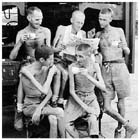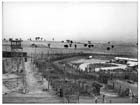Australian and Allied prisoners of war
The initial Japanese advance in early 1942 overran a number of isolated Australian garrisons on the islands of Timor, Ambon and New Britain. In all three cases Australian surrenders were met with atrocities of varying scales on the part of the Japanese. On New Britain 1,049 Australians were taken prisoner of whom 158 were promptly massacred at the Tol Plantation. The remaining prisoners were placed in camps near Rabaul where conditions seem to have been tolerable.
In late June the Japanese decided to send all of the prisoners, with the exception of some officers and civilian internees, to work as forced labourers in Japan. On 1 July the Japanese transport ship carrying the prisoners, the Montevideo Maru, was sunk by an American submarine in the South China Sea. At least 850 Australians died in this tragic attack (as the Japanese ship was unmarked there was no way the American submarine could know that Allied prisoners were on board).
After New Britain the Japanese appear to have instigated a policy of not keeping prisoners for the rest of the New Guinea campaign. Evidence from the Kokoda and Milne Bay battles suggests that if Allied soldiers were taken prisoner they were executed within days or weeks of their capture. Only one Australian soldier is known to have survived being captured in New Guinea after 1942. Allied airmen shot down over Rabaul and other Japanese- held territory suffered a similar fate with most being executed soon after their capture.
Japanese prisoners of war
Only a few hundred Japanese were taken prisoner by Australian and American troops in New Guinea during the war. This was due to a number of factors. First of all the Japanese military regarded surrender as a personal disgrace to be avoided at all costs. Most Japanese soldiers preferred to fight to the death or take their own lives rather than surrender. Many of those who were taken prisoner gave false names to spare their families back in Japan the shame of finding out their son/husband/father had surrendered to the enemy. Some of those taken prisoner were actually Korean or Taiwanese conscripts who did not share these beliefs.
Another factor was the reluctance on the part of Australian and other Allied troops to take Japanese prisoners. News of Japanese atrocities like the Tol Plantation massacre hardened Allied attitudes towards the Japanese and stories abounded amongst front-line soldiers of incidents where Japanese troops had supposedly surrendered only to kill their would be captors and themselves with concealed hand grenades and so on. Thus many front-line Allied soldiers preferred to shoot first rather than risk their own lives for the sake of an enemy whose own apparent disregard for the rules of surrender had become legendary.
However when Japanese prisoners were taken (and Allied commanders and intelligence officers were constantly reminding the front-line troops of the importance of doing so) they were treated well and in accordance with the 1929 Geneva Convention. A total of 5,637 Japanese prisoners of war (from all over the South Pacific and Indonesia) were sent to prisoner- of- war camps in Australia before the war ended. During that time the only serious incident to occur was the attempted breakout by Japanese POWs at their camp in Cowra, New South Wales in August 1944. Four Australian guards and 234 Japanese prisoners were killed during the breakout and while some Japanese did escape into the surrounding countryside they were all recaptured within a few days.
After Japan's capitulation in August 1945 all remaining Japanese forces in New Guinea formally surrendered to their Australian counterparts. Suddenly the Australian authorities found themselves responsible for some 140,000 Japanese prisoners where they had previously only had to deal with hundreds. During September all of these prisoners were gathered together in POW camps on the island of New Britain. Due to shortages of shipping the last of these prisoners was not repatriated to Japan until June 1946. With the cessation of hostilities the Allies also set about hunting down Japanese military personnel wanted for war crimes against Allied troops and civilians and putting them on trial. Australia took part in this process and a total of 924 Japanese were charged with war crimes by Australian military courts of whom 148 were found guilty and sentenced to death while 496 others were convicted and imprisoned.

AWM P01182.005

AWM 016310

AWM 06345
